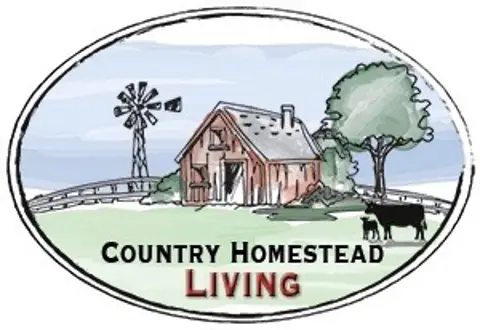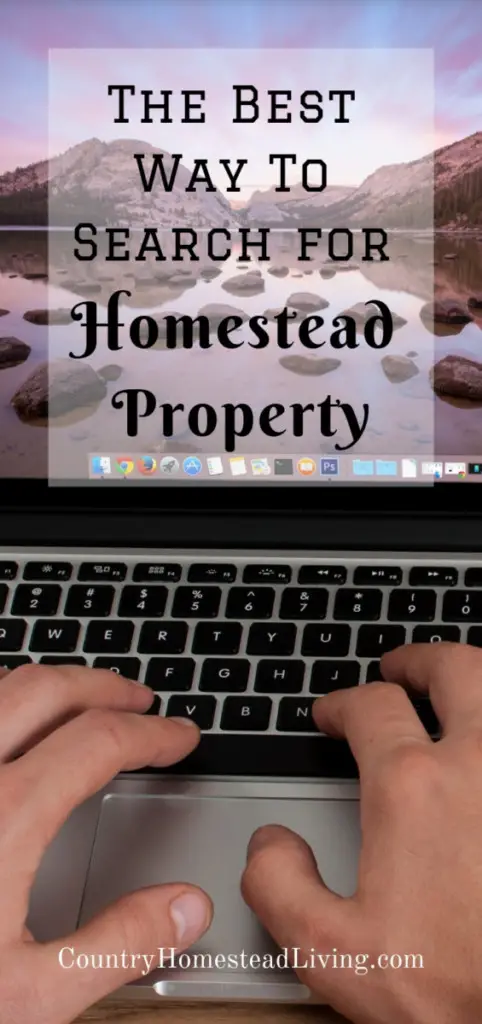Did you know that the proper way to search for country or homestead property begins long before ever considering contacting a Real Estate Agent?
Sadly, many are unaware of this fact.
Since the most expensive purchase one makes in their lifetime is to purchase a house and land it makes good sense to research all aspects of where you want to live.
Before actually looking at property.
So what would be the best way to search for homestead property?
The best way to search for country or homestead property is to use the internet from the comfort of your home, decide where you want to look for land and learn the land values in your chosen area before ever contacting a Real Estate Agent.
There is a proven systematic method to doing this that gives the users the knowledge of where the best areas for them to look are located.
Gives the users of the method a good idea of the land prices in their chosen area or areas.
Allows them to contact a Real Estate Agent from a position of knowledge instead of a position of dependence upon that Real Estate Agents preferences.
Where Do You Want To Look For Land?
We all have our favorite places we would like to live.
Many times those places are favorites because of a vacation spent in the area or a book we have read or even a movie we have seen.
But do you really know what that area is like all year round?
A fantastic place in summer can turn into a dreary, cold and terrible place to spend a winter.
Likewise, an area that is absolutely fabulous in the winter can turn out to be hot, muggy and overrun with nasty insects in the summer.
A good place to start in your search from home is to query the climate and weather for the area or areas you feel you would like to live in.
Pay particular attention to the average monthly temperature for the entire year, the average number of days of sunshine each month and the average rainfall or snowfall for each month of the year.
This gives you a basic understanding of what each season of the year is like at that location.
If you want to raise a garden, plant berry bushes or have an orchard pay attention to the Plant Hardiness Zone and the average number of growing days for the areas chosen.
The average number of growing days is usually defined as the average length of time between the last frost in the spring and the first frost of fall for that area.
Have A Basic Concept Of Micro-Climates
A micro-climate, sometimes written without the hyphen in the middle, is an area that is either warmer or colder than the surrounding areas.
A micro-climate can be as small as a few acres or as large as the area protected by a mountain’s down wind shadow.
In a hot summer climate a micro-climate could be an area where the prevailing winds blow across a lake and the down wind area of the lake is cooler by several degrees than the up wind area of the lake.
In wintertime, a mountain can split the cold winds that blow from a northerly direction.
The area in the mountain’s down wind shadow can be several degrees warmer than the areas on either side where the cold wind blows.
A micro-climate cooled by wind blowing over a lake in the hot summer can give a lot of relief from the heat and a garden located there can require less water for plant growth.
A micro-climate in a mountains down wind shadow can have several days to a month longer growing season than the areas on either side of that down wind shadow.
In the northern hemisphere you want land that faces south to take advantage of passive solar heating in the winter and for the best garden and orchard spots in summer.
In the southern hemisphere you want land that faces north to have the same advantages.
Talk with locals about where areas of micro-climates are located.
If you have a vehicle with an outside thermometer you can watch the temperature as you drive around the countryside which helps to locate micro-climates.
Using The Internet To Research Land
Many people will skip the steps of determining if their preferred areas are suitable all year round and not worry about micro-climates in their excitement to look for land on the internet.
Don’t skip researching your preferred areas and having a basic understanding of micro-climates.
Failure to do this research will always place you at a disadvantage when looking for land.
While you are in the deciding phase of your search, still deciding on where your preferred areas are, it is best to use a website that allows you to search nationwide.
These websites will give you a good idea of the prices of land in the different areas you are interested in living.
It is a big mistake to assume that land prices are the same everywhere.
Land prices vary considerably across the Country.
Having a knowledge of the land values in an area is the best protection against paying too much for land!
Best Websites To Begin Your Research For Land
It is best to use websites that are nationwide or at least a large area of the nation.
The recommended websites listed are specific for the U.S.
If you live in another Country or are interested in moving to another Country you will need to research and determine the best websites to use for that Country.
Different websites will have different features incorporated into their website.
Sometimes it is possible to get a better picture of an area by looking at property in that area that is listed on more than one website.
For example
One website might have a feature comparing the price of houses in a rural area to the prices of houses in the nearest town or the State average price of houses.
Another website might have a feature such as “see reported crimes near this home.”
If you can combine the information from these two websites and learn that homes looked at on both websites were in the same general area you have information on both the prices of the homes and also on crime in the area.
Information that you would not have had if you did not combine information from more than one website.
Most websites list property in categories such as city, suburban and rural.
Then property is listed in areas of the State such as by Counties or geographic regions such as the western, central or eastern portions of the State.
Other websites may list rural, (country property) by land size.
In that case try a query such as “Country Homes with 10-20 acres” to find listings.
Now for a brief description of websites.
Homes.com
Homes.com has pictures and price plus price per square foot.
In the section on each home describing the home there may be what seems at first to be conflicting information.
An example is Heating: Radiant Space Heaters and Heating Fuels: Wood.
Don’t let entries like this confuse you.
In a listing for a rural home it usually means that the homes heat is supplemented in winter by burning wood in a wood stove.
A second possibility is that wood heat is the primary source and the space heaters can be set to come on when the inside temperature gets down to say 50 degrees.
This could be the case if you were away from home all day in the winter time.
The fire in the wood stove could go out and the space heaters keep the water pipes from freezing.
When you return home a new fire is built in the wood stove to heat the house back up.
Realtor.com
Realtor.com has an Around the neighborhood feature that gives a price/square foot of any house on the property.
Compare that price to the price of housing in the nearest town and the State Average which may be listed also.
As a general rule, rural housing should not be more expensive per square foot than a house in town or the State average.
Also, be cautious about any property without indoor bathrooms and septic systems.
Likewise be cautious if the water source is a spring, creek, or river instead of a well.
The price for house lacking indoor bathrooms and wells should not be above the price/square foot in the nearest town or the State average.
Note: Realtor.com seems to be for western States.
Realty.com seems to be the same type of website for eastern States.
Remax.com
Remax.com is a nationwide website that has limited information.
It may not always list the acreage of undeveloped or raw land.
Listed information may be limited to price, days the property has been on the website and square footage and number of bedrooms of any house on the land.
Trulia.com
Trulia.com has a feature called See reported crimes near this home that may list crimes committed near rural homes.
Carefully compare Home Details (Realtor’s description) with Public Records (both accessed on trulia.com) to see if the acreage is the same both places.
You may find that the Home Details says 10 acres but the Public Records says 9.86 acres.
In some States you can apply for reduced property taxes if the property is rural and 10 or more acres.
Also beware of Realtor’s statements such as perc tested and septic approved in 2009.
(Actual statement on a parcel of land in my area listed on this website.)
In many areas of the U.S. the local health department’s septic approval is only good for one year.
To extend approval longer than one year requires an additional fee/year to be paid.
After 5 years typically, less in some cases, the entire permitting and perc testing process has to be repeated.
So a statement of septic approval years ago only means it was approved years ago.
It should be able to be approved again after the payment of fees and testing but it is not currently approved.
Unitedcountry.com
Unitedcountry.com is the website for United Country Real Estate, one of the oldest and most widely respected nationwide realty companies in the U.S.
They list country homes, ranches, farms and undeveloped land.
Their listings are in most States.
Search the listings using key words such as “Country Homes with 10-20 acres.”
Zillow.com
Zillow.com has a price/tax history that tells if the property has been listed recently at a higher or lower price.
And usually gives the acreage on land parcels.
Beware of the Zestimate feature though.
It is supposed to let you know the properties actual value.
Many times this value appears to be based on the 120 biggest markets (cities) or on some formula that is applied across the board nationwide.
There are many instances where the Zestimated value for rural land is thousands of dollars above that properties real value.
Also be extremely suspicious if the property is listed for 3 or 4 times the most recent Property Tax Assessment.
Another time to be suspicious is if there is a high dollar property listed without a property tax record.
Craigslist.com
Craigslist.com sometimes has country homes and land for sale.
May be listed under Real Estate For Sale.
The properties listed are usually FSBOs, For Sale By Owner.
Many times there is no picture and just a bare minimum written description.
Contact information may be limited to a phone number or an e-mail address.
Don’t be discouraged by the lack of information.
I know of more than one family who found their Country Home on Craig’s List.
These websites usually have listings by State and many times by County as well as by City.
Be careful when looking at remote rural land listed by a Realtor.
Much of the time these remote lands are listed for the same price per acre as land that is out of the city limits but is on a paved or county maintained gravel road.
Two caveats to remember
1) remote rural land, especially land on a private road is worth less than land on a paved or a county maintained road.
2) Land values decrease as distance to town increases.
Foreclosure Websites
Occasionally you may find a good country property on a foreclosure website.
However, I cannot recommend searching foreclosure websites for property.
You typically have to give credit card information and pay a monthly fee for the use of the website.
If you decide to offer on a property, that offer must be made through a Realtor.
I will mention three Foreclosure Websites.
Homepath.com
Homepath.com is Fannie Mae’s foreclosure web site.
It only lists homes in residential areas and does not list land.
Hudhomes.com
Hudhomes.com is probably the most reputable foreclosure website.
It lists land nationwide that did not sell at a foreclosure sale.
You must register and give a credit card number to be able to see details on houses and land.
Once registered you have 7 days free trial before your credit card is billed an automatic monthly fee.
If you find property you like, you must bid on it using a Realtor.
Realtytrac.com
Realtytrac.com is a good website to avoid!
It has been reported numerous times for rude personnel who go ahead and bill credit cards even after the card holder has cancelled a subscription!
It is very difficult to get the money refunded after a credit card has been billed.
Additionally there are several reports of homes being listed that have never been in foreclosure! CAVET EMPTOR!

How To Analyze Country Homestead Property On Websites
I will be using Zillow.com as the template for how to analyze properties.
First:
Look at the Price Tax History.
In some parts of the U.S. the value of country property is just beginning to come back to the value in 2007/2008 before the Real Estate Market crashed.
One way to determine this is to examine the Price/Tax History.
Focus on the Tax History. Several properties will have years of Tax History listed.
Compare the current year or the last listed year with the Tax Valuation in 2007 or 2008.
If the current year or last year listed is less than 2007/2008 this could mean that the values in that area have not recovered to the 2007/2008 peak values.
The Price Tax History can give you an idea of how long the property has been on the market and if the asking price has changed.
Property that has been listed for more than 180 days, (6 months), and has had one or more price reductions can indicate a property that is still overpriced for the local area.
As an example
There was a property listed on Zillow that had almost 100 acres, house, barn, shop, trees, good well etc.
It was listed in 2013 for $1.9 million.
Two months later the price was dropped to $1.2 million probably because the property was way overpriced.
The house was taken off the market 11 months later in August 2014.
In May 2017 the house was placed on the market again for $685,000.
All this information was on the May 2017 listing on Zillow!
Admittedly this is an unusual example. but it shows the effects of an unrealistic asking price usually advised by a younger, relatively inexperienced Real Estate Agent listing the property.
In most parts of the U.S. property is reassessed for taxes every 5 years by an onsite assessment.
This assessment is usually within about 10% of the property’s actual value.
Second:
If there is no Price/Tax History on a piece of property you are interested in contact the Real Estate Agent.
And request a printout of the Property Tax assessments for the last 10 years.
Some Real Estate Agents may leave the Tax Assessments off the listing because they do not support the asking price.
Third:
Look closely at the pictures with the listing.
Pay close attention to the pictures showing views of the land and access to the land. Views of the house are important, but so are views of the land and the access to it.
What is the lay of the land?
Is it flat, sloped or hilly?
Are there any woods, ravines, sources of surface water such as streams, ponds, etc.
Is there any indication that these sources of surface water are year round sources? (Maybe in the written description?)
Where is the house in relation to the nearest County maintained road?
In snow country, the farther away for a County maintained road the more access you will have to snow plow or pay to be snow plowed to get out in winter.
Can you tell from the pictures if you will need a 4WD vehicle during the winter?
Fourth:
What is the age of the house?
The older the house, the greater the chance it is not properly insulated.
If not properly insulated it will be harder to cool in summer and more expensive to heat in winter.
What type of heating system does the house have?
We rented a house that was 30 years old and was heated by an oil furnace.
This was in snow country and the house was not adequately insulated for the area.
It cost twice as much to attempt to heat the house as it would have been with proper insulation.
Even running the oil furnace full blast the house was never really warm in the wintertime!
Fifth:
Is the house located in a valley, on a bench between the valley and hilltop or near or on top of a hill or mountain?
Where the house is located will determine the heating and cooling problems and the growing season for a garden.
Example
In snow country a property in a valley can have a shorter growing season than a property on a bench 500 feet higher in elevation!
Why?
At night the cold air from on top of the mountain sinks down to the valley.
Also at night the humidity increases and will be more in the valley than at higher elevations.
So the combination of cold and higher humidity increases the chances of a killing frost in mid-June in a valley.
The best location for a growing season in snow country or in mountainous country is about 500 feet above the valley floor.
The elevation is high enough to avoid those mid-June killing frosts and the sun warms the 500 foot level before it warms the valley.
This can give a full month longer growing season 500 feet above the valley than the growing season in the valley.
Sixth:
If on realtor.com compare the price per square foot of the house to the price per square foot of houses in the nearest town and State wide.
The Rule of Thumb is…
The farther a property is from town the less it is worth.
Part two of the rule of Thumb is…
No house is worth what it would take a custom builder to build an exact replacement at today’s prices!
Seventh:
By matching the area you are interested in with the same area of houses listed on trulia.com you may be able to use the see reported crimes near this home feature to get an idea of crime in the areas you are interested in.
By starting your research for Country or Homestead Property from the comfort of your home via web searches you will be a smarter buyer.
And make much better choices of areas and property to look at!
Related Questions
Is homesteading still possible?
Yes, but there are no more large tracts of land available to homestead for free.
Those programs ended in 1976 for the 48 lower States and in 1986 for Alaska.
There may be a free city lot or two in Nebraska or Iowa for those who want to build a house and live on a city lot.
What is the most profitable farm animal?
It depends upon how much land you have.
You have to size your livestock to the amount of grazing land you have.
On a small homestead you might be limited to raising chickens.
On a large homestead you can raise cattle.
You must decide what the most profitable animal is on the land you have.
What is the most profitable crop?
Like the above question, it depends upon how much land you have.
On a small homestead tomatoes might be the most profitable crop.
On a large homestead wheat or corn might be the most profitable crop.
In the final analysis, it is up to you to make that determination based upon how much land for crops you have.


